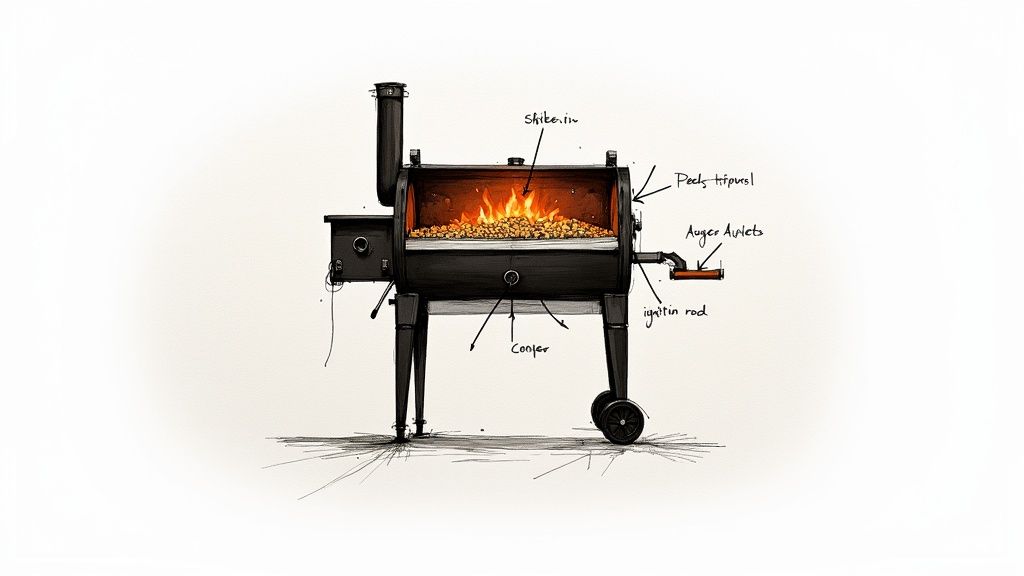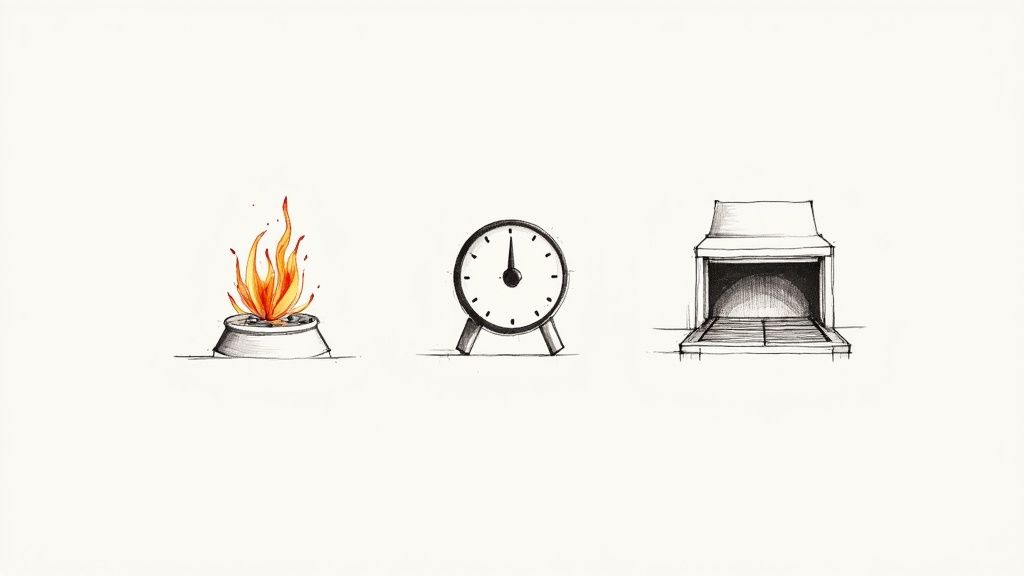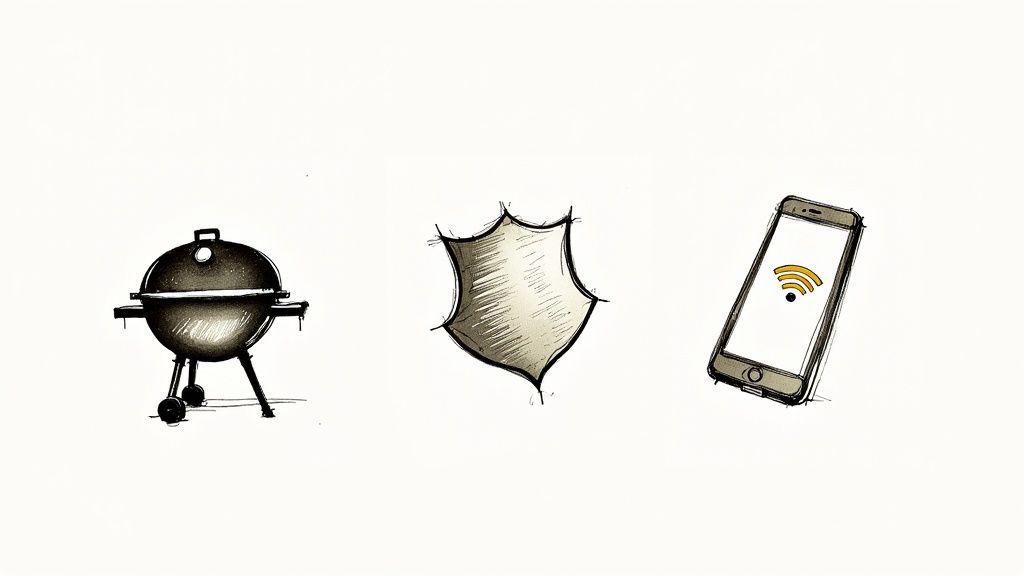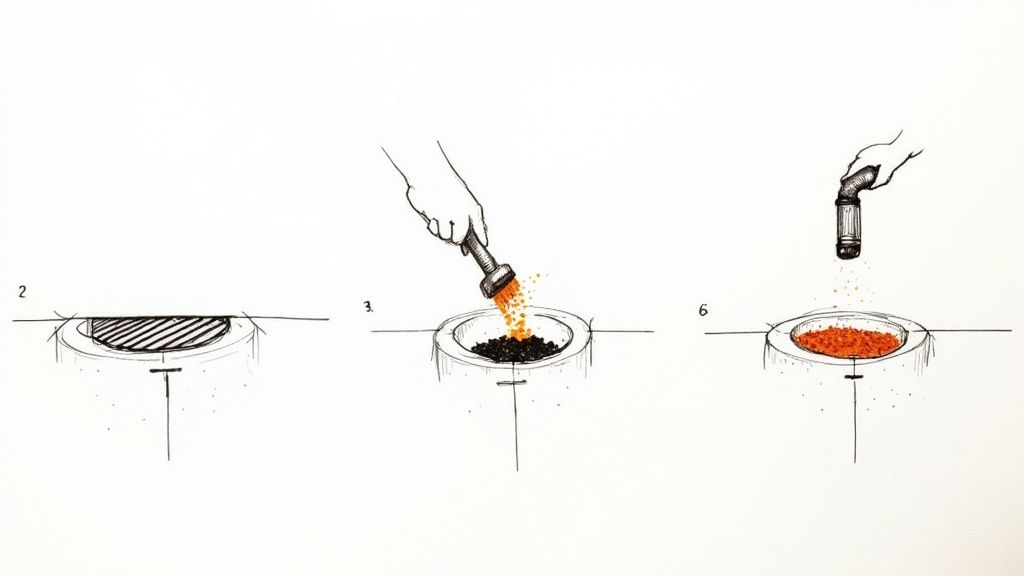The Ultimate Pellet BBQ Grill Guide
So, what exactly is a pellet BBQ grill?
Think of it as a clever, wood-fired convection oven you use in your garden. It gives you all that incredible, authentic smoky flavour from real wood, but with the 'set-it-and-forget-it' ease of a modern kitchen appliance. In short, it’s precise temperature control at the push of a button.
How a Pellet BBQ Grill Actually Works

If you can use your oven at home, you can easily master a pellet BBQ grill. It’s a pretty simple concept. You set your kitchen oven to 200°C, and a thermostat makes sure it stays there. A pellet grill does the exact same thing, but it’s fuelled by 100% natural hardwood pellets, which deliver a depth of flavour that gas or electric cookers just can't touch.
This kind of automated precision is getting seriously popular. The UK pellet grill market is booming, tapping into our national love for a good barbecue. In fact, projections show the European market for pellet grills is set to hit around $236.76 million USD in 2025, and the UK makes up a whopping 16.6% of that. That tells you just how many home cooks are cottoning on to this clever bit of kit. You can read more on the European pellet grill market from Cognitive Market Research.
At its core, a pellet grill is just four key parts working in perfect harmony to create a stable, smoky cooking environment.
The Key Components
- The Hopper: This is basically the fuel tank. It’s a container, usually on the side of the grill, where you pour in your wood pellets. A full hopper can keep you cooking for hours – whether that’s a quick weeknight burger session or an all-day low-and-slow brisket.
- The Auger: Imagine a big corkscrew at the bottom of the hopper. When you punch in a temperature, a digital controller tells this auger exactly how fast to turn, feeding a perfectly measured stream of pellets into the fire pot.
- The Hot Rod & Fire Pot: As the pellets drop into the fire pot, an electric hot rod ignites them to get the fire started. Once they're smouldering nicely, the hot rod turns off. The fire is then kept alive by the steady flow of new pellets and air from the fan.
- The Induction Fan: This fan is crucial. It circulates air around the cooking chamber, spreading heat and smoke evenly all over your food. It’s this convection-style cooking that makes a pellet grill so versatile for smoking, baking, roasting, and grilling.
In essence, the digital controller is the brain, the auger is the hands, and the fan is the lungs of the operation. Together, they automate the single hardest part of traditional smoking—managing the temperature—so you can focus on the flavour.
This automated system is what really sets a pellet BBQ grill apart from the rest. It takes away all the guesswork and constant babysitting that comes with a charcoal fire, giving you the freedom to step away and trust that your food is cooking perfectly.
Once you get your head around how these simple parts work together, you can really appreciate the smart engineering that makes incredible, wood-fired cooking so easy.
The Real Advantages of Pellet Grill Cooking

So, why are so many people—from seasoned pitmasters to busy families—ditching their old BBQs for a pellet grill? It really boils down to three massive perks: unbeatable flavour, dead-on precision, and frankly, ridiculous versatility.
Once you get a taste of what these machines can do, you'll see why they're taking over the outdoor cooking world. They perfectly blend the authentic, smoky goodness of cooking with real wood and the set-it-and-forget-it ease we all crave.
Superior Wood-Fired Flavour
Let's be honest, the single biggest reason to get a pellet grill is the taste. You simply can't fake the deep, smoky flavour that comes from burning 100% natural hardwood. It's a world away from what a gas grill can produce.
And we're not just talking about a generic "smoke" flavour. This is your chance to play with fire, literally. Change the pellets, and you completely change the character of your food.
- Hickory: This is your classic, bold BBQ flavour. Perfect for pork and beef.
- Cherry or Apple: These offer a milder, sweeter smoke that’s absolutely beautiful with chicken, fish, and even vegetables.
- Mesquite: Got a big cut of red meat like a brisket? Mesquite brings a strong, earthy smoke that can stand up to it.
The real fun begins when you start mixing and matching. You can create your own custom flavour profiles using different types of Smokey Rebel Wood Pellets. Imagine smoking ribs with a base of hickory, then finishing them with a hint of cherry for a touch of sweetness. That kind of control is what separates good barbecue from truly great barbecue.
Unmatched Temperature Precision
Ever tried to keep a charcoal grill hovering at a steady 110°C for an eight-hour smoke? It’s a nightmare of fiddling with vents and topping up coals. A pellet grill completely sidesteps that entire battle, all thanks to its digital brain.
Think of it as cruise control for your BBQ. You just dial in the temperature you want, and the controller takes over. It constantly monitors the heat inside the grill and tells the auger exactly how many pellets to feed the fire to keep things rock steady.
This is the secret to getting ridiculously consistent results. It means you can throw a pork shoulder or brisket on for an overnight cook and actually go to sleep, knowing the grill will hold your target temperature for hours on end. No more babysitting the fire.
This pinpoint control isn’t just for low-and-slow cooking, either. Need to sear a steak at a blistering 260°C? A quality pellet grill will hit that temperature and stay there, giving you a perfect crust without the wild flare-ups you get from gas. It’s this reliable performance, from low to high heat, that makes cooking on a pellet grill so rewarding.
Incredible Versatility
A pellet grill isn't just a smoker. Because it basically works like a wood-fired convection oven, it can do so much more. It's a true all-in-one bit of kit for your garden.
This one machine can genuinely replace several others, which saves you space and money. Its ability to hold a huge range of temperatures so steadily means you can cook just about anything you can think of.
One Grill, So Many Ways to Cook:
- Smoke: The king of low-and-slow for brisket, pulled pork, and ribs.
- Grill: Smashes out burgers, sausages, and steaks with that amazing wood-fired taste.
- Bake: Yep, you can bake. Think pizzas, fresh bread, and even biscuits with a subtle smoky twist.
- Roast: Perfect for Sunday roasts, whole chickens, and Christmas turkeys that come out juicy with crispy skin.
- Braise: Chuck a Dutch oven in there for incredible slow-cooked stews and pot roasts.
This do-it-all nature is what lets you get really creative. You could smoke a pork butt for hours, then crank the heat to bake an apple crumble for dessert—all on the same grill. It’s this jack-of-all-trades superpower that makes a pellet grill such an exciting piece of equipment for any food lover.
How to Choose the Right Pellet BBQ Grill

Ready to buy your first (or next) pellet grill? It’s an exciting moment, but let's be honest, the number of options out there can make your head spin. The trick is to tune out the noise and focus on what actually matters for you – your cooking style, your garden space, and your budget.
Forget the marketing hype. We’re going to break down the essential factors so you can find a grill that’ll become the heart and soul of your outdoor cooking for years to come.
Consider Your Cooking Area and Capacity
First things first: who are you cooking for? A grill’s cooking area, measured in square inches, tells you exactly how much food you can cook at once.
- Small (Under 500 sq. in.): Ideal for couples, small families, or anyone working with a balcony or a tight patio space. You can still easily knock out a whole chicken or a full rack of ribs.
- Medium (500-800 sq. in.): This is the sweet spot for most households. It gives you plenty of room to cook mains and sides at the same time, perfect for when you have a few friends over.
- Large (Over 800 sq. in.): If you’re the person who hosts the big family get-togethers, this is where you need to be. These beasts can handle multiple briskets or several pork shoulders without breaking a sweat.
Size is a huge deal, especially in urban areas. With more people living in flats, particularly in London, there's a growing need for compact grills that fit smaller outdoor spaces. The Office for National Statistics found that in 2022, around 81% of London households had access to some sort of private outdoor space, but a lot of that is patios and balconies. This trend has really shaped the market, which you can see in UK BBQ market insights from Verified Market Research.
Evaluate Build Quality and Materials
A good pellet grill is an investment, so you want one that’s built like a tank. The materials make all the difference in how long it lasts and, more importantly, how well it cooks.
Look for a grill made from heavy-gauge steel. It’s not just about feeling sturdy; thicker steel holds heat far better, which is absolutely critical for keeping your temperatures stable, especially on a chilly British evening.
Stainless steel components are another non-negotiable for quality. They stand up to rust and corrosion, particularly on the bits that see the most action—the grates, lid handle, fire pot, and heat deflector. A well-made grill will have a solid, heavy lid that seals tight, keeping all that glorious smoke and heat where it belongs.
Look for Smart and Practical Features
Modern pellet grills are loaded with tech designed to make your life easier and your food more delicious. Some features are genuinely game-changing.
Key Features to Look For:
- Wi-Fi & Bluetooth Connectivity: Being able to control your grill from your phone is a game-changer. You can change temps, check on your meat probes, and set timers from your sofa. No more babysitting the BBQ.
- Integrated Meat Probes: Most decent grills come with at least one probe that plugs right into the controller. This lets you monitor the internal temperature of your meat without opening the lid and losing all that precious heat.
- Easy Ash Cleanout Systems: A simple slide-out pot or tray to dump the ash makes the end-of-cook cleanup so much faster and less messy. Trust me, you'll appreciate this.
- Hopper Capacity: A bigger hopper means longer cooks without refilling. If you’re planning any epic overnight brisket cooks, this is a must-have.
Think about how a grill fits into your wider outdoor life, too. For trips away from home where portability is key, something like a titanium packable stove can be a great companion to your main setup. At the end of the day, the best features are the ones you'll actually use, so think about what will genuinely make your cooks better and more fun.
Unlocking Incredible Flavour on Your Grill
Knowing how a pellet grill works is one thing, but turning that knowledge into a plate of unforgettable food is where the real magic happens. It’s time to connect the machine to the meal and move from theory to delicious reality.
These three mini-guides will show you exactly how to get amazing results for some of the most iconic barbecue dishes. Think of them as your launchpad to flavour heaven.
Mini-Guide 1: The Perfect Pulled Pork
Pulled pork is a true low-and-slow classic, and a pellet grill makes it almost foolproof. The secret is consistent heat, a great seasoning to build that beautiful "bark" (the dark, flavourful crust), and a whole lot of patience.
- Preparation is Key: Start with a pork shoulder, often called a Boston butt. Trim off any excessive hard fat, but leave a thin layer to keep things moist while it cooks.
- Season Generously: Slather on a binder like a thin layer of mustard or olive oil to help the rub stick. Then, coat the entire shoulder liberally with Hickory Hog Pork Rub. Don’t be shy—this is where your bark comes from. This rub is packed with authentic flavour and contains no added crap, letting the pork shine. Let it sit for at least an hour, or even better, overnight in the fridge.
- Set the Grill: Preheat your pellet grill to 110°C (225°F). This low temperature is absolutely crucial for slowly breaking down those tough connective tissues and rendering the fat.
- Smoke for Hours: Place the pork shoulder directly on the grates and just let it smoke. You're looking for an internal temperature of around 70°C (160°F), which is when the infamous "stall" often happens.
- Wrap and Finish: To push through the stall, wrap the pork tightly in foil or butcher's paper. Pop it back on the grill and continue cooking until the internal temperature hits 93-96°C (200-205°F). It should feel incredibly tender.
- Rest and Shred: Let the pork rest for at least an hour before you even think about shredding it. This allows all those amazing juices to redistribute, giving you incredibly moist meat.
The consistent, smoky heat of the pellet grill does most of the heavy lifting. Your job is to lay the flavour foundation with a quality rub and let time do the rest.
Mini-Guide 2: Flawless Grilled Chicken
Forget dry, boring chicken. A pellet grill can give you thighs with ridiculously crispy skin and juicy, flavour-packed meat inside. The trick is a simple two-stage cooking process.
- Pat Dry and Season: For crispy skin, moisture is the enemy. Pat your chicken thighs completely dry with a paper towel.
- Bring the Flavour: Coat the chicken with a zesty, smoky seasoning. The Chipotle Cowboy Chicken Rub is perfect for this, delivering a kick of authentic spice without any of the nasty additives.
- Low Heat First: Set your grill to a moderate temperature of 180°C (350°F). Cook the chicken thighs until their internal temperature reaches about 70°C (160°F). This initial stage gently cooks the meat all the way through.
- Crank It Up: Now for the magic. Take the chicken off, crank your pellet grill to its highest setting (around 230-260°C / 450-500°F), and let it get roaring hot.
- Sear for Crispy Skin: Place the thighs back on the grill, skin-side down, for just a few minutes until the skin is golden and crispy. Watch it like a hawk to prevent burning.
- Check and Serve: The final internal temperature should be at least 74°C (165°F). Let it rest for a few minutes before diving in.
Mini-Guide 3: Smoked Brisket Made Simple
Brisket is the undisputed king of barbecue, but it can be intimidating. This approachable method demystifies the whole process, proving that anyone with a pellet grill can tackle this BBQ titan. Success all comes down to a simple, quality rub and unwavering temperature control.
- Trim and Season: Start with a whole "packer" brisket. Trim the hard fat, leaving about a 6mm (¼ inch) layer on the fat cap. For a cut this magnificent, you need a rub that complements the beef, not overpowers it. A foundational blend like Revolution Beef Rub is ideal. Coat the entire brisket evenly.
- Set Your Temperature: Preheat the grill to 120°C (250°F). A slightly higher temperature than you'd use for pork helps render the brisket's dense fat more effectively.
- The Long Smoke: Place the brisket on the grill, fat-side up. Let it smoke until it develops a deep, dark bark and reaches an internal temperature of around 75°C (165°F).
- Wrap for Tenderness: Just like with pulled pork, wrapping is the key to a tender result. Wrap the brisket tightly in unwaxed butcher's paper, which helps retain moisture while preserving the bark far better than foil can.
- Finish the Cook: Return the wrapped brisket to the grill and cook on. The target internal temperature is between 93-96°C (200-205°F), but the real test is feel: a probe should slide into the thickest part of the meat with almost no resistance.
- The Crucial Rest: This is non-negotiable. Let the brisket rest in a warm place (like an insulated cooler) for at least 1-2 hours before slicing against the grain.
Mastering these core recipes will give you the confidence to start experimenting. To learn more about how different woods can impact your cooks, check out our guide on choosing the right smoked wood for your BBQ.
Simple Maintenance to Protect Your Grill

A well-maintained pellet grill isn't just about making it last longer; it's about making better food. Simple as that.
Keeping your machine in top nick ensures it cooks efficiently, holds temperatures bang on, and delivers that flawless, smoky flavour every single time. Don't think of maintenance as a chore. It's a quick ritual that protects your investment and sets you up for the next delicious cook.
These simple routines are designed to be fast and effective, preventing common headaches like temperature swings and pellet jams before they can even start. Spend just a few minutes on upkeep, and you'll guarantee your grill performs perfectly for years to come.
Your Post-Cook Cleanup Routine
This is the quick, five-minute reset you should get into the habit of doing after every single cook. It’s the easiest way to prevent build-up and keep your grill ready to roll at a moment's notice.
- Brush the Grates: While the grill is still warm (but not scorching hot), grab a sturdy grill brush and scrape off any food residue. This is a hundred times easier than tackling baked-on grease once it's completely cold.
- Empty the Fire Pot: Ash is the natural byproduct of burning wood pellets. After the grill has totally cooled down, use a small scoop or a shop vac to clear the ash from the fire pot. Too much ash can smother the hot rod, leading to ignition failures next time you fire it up.
This simple two-step process stops grease and ash from becoming a bigger problem down the line, ensuring a clean start for whatever you're cooking next.
Periodic Deep Cleans for Peak Performance
Every 5-6 cooks, or after a particularly long and greasy session like a pork butt, it’s worth spending a bit of extra time on a deeper clean. This is what keeps your grill running like a finely tuned instrument.
A clean grill is an accurate grill. Grease and carbon build-up on internal components, especially the temperature probe, can cause dodgy readings and spoil your results.
Your deeper clean should include:
- Vacuuming the Barrel: Once you’ve taken the grates and heat baffle out, use a shop vac to suck out all the accumulated ash and gunk from the bottom of the grill barrel. This prevents rust and seriously improves airflow.
- Cleaning the Temperature Sensor: Gently wipe down the internal temperature probe with a clean cloth. A layer of grease can insulate the sensor, causing the grill to run hotter or colder than the temperature you’ve actually set.
- Wiping Down Surfaces: Give the interior and exterior of the grill a good wipe-down with a damp cloth to get rid of any grease splatter. This not only keeps it looking sharp but also prevents long-term corrosion.
Maintaining Hopper Health
The hopper and auger system are the heart of your pellet grill, so keeping them in good shape is non-negotiable. The number one rule? Keep your wood pellets dry.
Moisture is the absolute enemy of wood pellets. If they get wet, they’ll swell up and turn into a sawdust-like paste that will clog your auger solid. Always store your bags of Smokey Rebel Wood Pellets in a dry, sealed container, well away from the elements.
If you know you won't be using your grill for a while (like over winter), it's a smart move to empty the hopper completely. Just run the grill on a high temperature until all the pellets in the auger tube have been burned off. This stops them from absorbing ambient moisture and causing a jam when you finally fire it up again.
FAQs: Your Pellet BBQ Grill Questions Answered
Look, even with all the excitement around getting a new bit of kit, it's normal to have a few questions before you splash the cash. We get it. This section tackles the most common queries we hear from new and soon-to-be pellet grill owners, giving you clear, straightforward answers.
Our goal is to iron out any last-minute doubts so your first cook is a belter.
Can You Actually Sear a Steak on a Pellet Grill?
Absolutely. Don’t let their low-and-slow reputation fool you. Most modern pellet grills can easily hit 260°C (500°F) or higher, which is more than enough heat to get a proper sear.
The trick for a steakhouse-quality crust is to pre-heat your grill to its absolute maximum setting. If you really want to level up, grab some cast-iron grates or a dedicated searing station to maximise that direct heat.
And for an unbeatable crust that locks in all the juices, season your steak generously before it goes anywhere near the heat. A top-notch, balanced beef seasoning like the Revolution Beef Rub is literally designed to build that perfect bark while making the meat taste even better.
How Many Wood Pellets Does a Grill Use per Hour?
This is a classic "how long is a piece of string?" question. Pellet use varies a fair bit depending on the cooking temperature, what the weather's doing (it'll burn more on a cold, windy day), and the grill itself. Still, you can use a rough guide to plan your cooks.
- Low & Slow Smoking (around 110°C): You’ll get through about 0.5 to 0.7 kg of pellets per hour.
- High-Heat Grilling (230°C+): Consumption jumps to around 1 to 1.5 kg per hour.
Golden rule: before starting a long cook like a brisket or pork shoulder, always make sure the hopper is completely full. It's also a smart move to keep a few extra bags of quality Smokey Rebel Wood Pellets stashed somewhere dry. You really don't want to run out halfway through.
What's the Difference Between Home and Commercial Pellet Grills?
The main differences boil down to three things: size, build quality, and price. Think of it like a family car versus a lorry—both will get you from A to B, but they’re built for completely different jobs.
Residential pellet grills are perfect for garden cooking, with enough space for family meals and small get-togethers. Commercial models, on the other hand, are built like tanks. They use heavy-gauge steel to handle the non-stop punishment of a restaurant kitchen.
Commercial units have much bigger hoppers, beefier auger motors, and a massive cooking area to pump out food all day long. While both types give you that pinpoint temperature control, the commercial ones are engineered for relentless reliability, which is why more and more professional kitchens are turning to them for consistent results.
As demand for proper BBQ and smoked food grows, you're seeing more of this tech in commercial kitchens, but the home-cooking boom means the residential market is still king.
Should I Soak Wood Pellets Before Using Them?
No. Never, ever soak your wood pellets. This is a common mix-up, especially for people used to smoking with wood chips on a charcoal or gas BBQ.
Unlike wood chips, which you often soak to get a slow, smouldering smoke, pellets are made from compressed sawdust with very low moisture. They are engineered to be used bone dry.
The grill's auger is designed to feed these hard, dry pellets into the fire pot for a clean, efficient burn. Soaking them makes them swell up and turn into a mushy paste. This gunk will instantly clog your auger, stop the grill from feeding fuel, and could seriously damage the motor. For the best results, always keep your pellets dry.
Ready to unlock some serious flavour? The right seasoning makes all the difference. Explore our authentic, no-nonsense BBQ rubs at Smokey Rebel and find the perfect partner for your next cook. Whether you're after a classic pork rub or something with a bit more fire, start your flavour journey with our Build Your Own Bundle.
Join our Mailing List
Sign up and get Smokey Rebel Recipes + weekly recipes straight to your inbox!
Recent articles
The Ultimate Pellet BBQ Grill Guide
Discover everything you need to know about a pellet BBQ grill. Learn how they work, their key benefits, and how...
Read moreYour Guide to Smoked Wood for BBQ Perfection
Discover the best smoked wood for BBQ in our guide. Learn to pair wood flavours with meats and master the...
Read moreA Modern Guide to BBQ with Wood Pellets
Master the art of BBQ with wood pellets. This guide covers pellet selection, temperature control, and pro techniques for perfect,...
Read more


